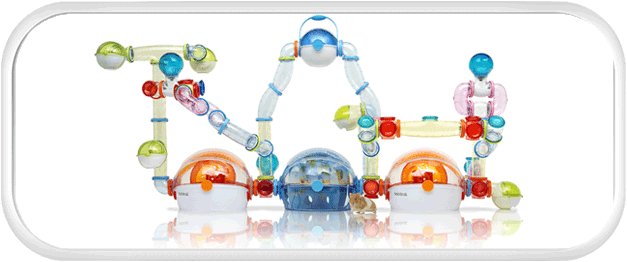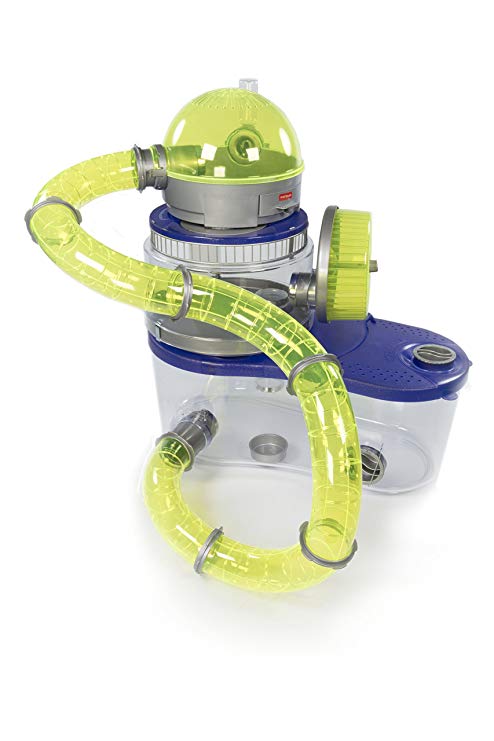Squeedles
This was originally a featured article in the July/August 2019 issue
Squeedles are harmless squid-like worms common in areas that are persistently damp or moist for most of the year on Terra-like worlds. They are amphibious scavenger/insectivores generally 10-15cm in length, with a mass of approximately 30g. They are brightly colored (pink and green) in contrast with their natural environment; this appears to deter many predators. Their bodies are tubular, with seven short tentacles and two long tentacles. Both sexes use the same body plan, differing only in coloration (Males are bright green except for the long tentacles, which are pink; females reverse the color pattern).
In their natural environment, they can breed very quickly and become a nuisance. In some clusters of worlds they may be encountered as a starport pest with the risk of them finding their way into galley areas and storage on starships where they can be hard to winkle out of crevices and crannies—hiding is a natural defense for them, as their unarmored bodies can tolerate very little damage before fatality. They may be considered from world to world as anything from vermin to pets to a delicacy.
| Squeedle—Classic Traveller Stats | ||||||
|---|---|---|---|---|---|---|
| No. | Animal | Mass | Hits | Armor | Wounds and Weapons | |
| 4 | Squeedle | 25g | 1/1 | None | 1 (tentacle) | A7F4S½ |
| Squeedle—Mongoose Traveller 1st Edition Stats | |||||||
|---|---|---|---|---|---|---|---|
| Type | Habitat | STR | DEX | END | INT | Instinct | Pack |
| Squeedle | |||||||
| Hunter (Omnivore) | Any damp/moist environ. | 1 | 6 | 3 | 0 | 8 | 4 |
| Athletics (endurance) 0, Deception 0, Recon 0, Survival 0, Telepathy 0, Telekinesis 0 | |||||||
| Tentacles (1), Psionic - special (see below), Number Encountered: 1d6-2 | |||||||
| Amphibious worm-like creatures with sticky tentacles, vivid colouring and hairy growths above their eyes that may be mistaken for eyelashes. | |||||||
| Squeedle—Mongoose Traveller 2nd Edition Stats | ||
|---|---|---|
| ANIMAL | HITS | SPEED |
| Squeedle | 1 | 3m |
| SKILLS | Athletics (endurance) 0, Deception 0, Recon 0, Survival 0, Telepathy 0, Telekinesis 0 | |
| ATTACKS | Tentacles (1), Psionic - special (see below) | |
| TRAITS | Amphibious, Psionic (3), Small (-4), | |
| BEHAVIOUR | Omnivore, Hunter | |
| Squeedle—Cepheus Engine Stats |
|---|
| 25g Hunter (Omnivore), Any damp/moist terrain, 163084, 1d6-2 Athletics 0, Recon 0, Streetwise 0, Survival 0, Telepathy 0, Telekinesis 0 Tentacles (1); Speed 3m [N.B. Streetwise and Navigation have been listed instead of Deception and Survival. Streetwise is here used to mean a deceptive ability for the squeedle to use local terrain and cover to its advantage. Referees can choose to add Deception and Survival to the Core Rules skills if desired as noted on p.33] |
Squeedles as Pets
The squeedle makes an easy pet that can show some recognition of owner and responds to affection with waving tentacles and fluttering ‘eyelashes’.
If you want to keep a squeedle as a pet then a modular system (see pictures), the more extensive and complicated the better, is highly recommended. This allows food to be provided in different sections (never put food in the ‘home’ area) and the modules rearranged on an irregular basis to keep the squeedles stimulated. It is also recommended that active live food such as skittle beetles and jubilee hoppers be provided approximately once a week, alongside their normal food to satisfy their need to hunt.

A more complex squeedle habitat. The modules should often be rearranged, and the module bottoms covered in changing materials, but rearrangement and fill-changing need not be as frequent as for the simple habitat.
To aid stimulation each module of the squeedle’s cage can be lined with a different substrate, e.g. moss, wood shavings, grit and so on. Ideally, keeping an entire squirm [the proper collective noun] of squeedles instead of only a single animal will result in generally healthier animals, though the habitat will necessarily be (possibly inconveniently) larger.
Referee’s Information
The one point of damage is inflicted as a stinging pain if the natural excretions of the squeedle come into contact with an open wound (even just a minor graze) or after 1D minutes of sustained contact. Otherwise, it simply feels slimy to the touch and can be washed off with relative ease. The stinging is considerably worse than that from e.g., nettles or a bee.
The point of damage is inflicted every 1D minutes thereafter; after three points of END are lost, further damage moves to INT as the stinging becomes unbearably distracting. This ‘damage’ heals at a rate of one point per hour per minute suffered. After 3 points of such INT damage, any additional wounds are applied to physical characteristics as usual as the secretions enter the blood stream.
For humans this is nearly inconsequential, if very uncomfortable, and easily avoided. For smaller prey or if something should cause an attack of several squeedles en masse, it can be more problematic. Best not to fall into a tank of them.
It has recently been discovered that squeedles have a potentially dangerous/debilitating psionic effect. When kept as pets, in conditions that do not require them to actively scavenge for their food, or kept on their own with no squirm rivalries or interactions, the squeedle emits a low level psionic field that keeps the owner(s) interested in looking after them. However, after an undetermined period of time this reduces the inborn intelligence level of the owner or handler. This means that complex tasks become increasingly difficult, eventually affecting the more mundane tasks in life, and finally resulting in a coma. What is not (yet) known by the research team investigating squeedles is that at the same time, the handler will heal at twice the normal rate.
1D months (the “period”) after first adopting a squeedle that is not appropriately stimulated, a handler will lose one point of Intelligence if an Average Endurance check is failed (the number of months in the period, P, is a negative DM on this throw). This loss will then, potentially, occur every subsequent period. Any sophont affected rolls separately for their individual period.
In the squeedle’s natural environment the psionic field generated by a squirm of squeedles means that the insects they hunt, e.g. an ants’ nest sentry, may not even be able to sense the squirm’s approach and raise the alarm.
Note: The original squeedle in which the psionic field was first observed, is still alive and well in an Imperial Research Station where her abilities are being closely monitored and studied. However, given the bias against psionic abilities generally, the location of The Institution is being kept a secret.
The Institution hopes to gather more squeedles and form a squirm. The squirm will then be released into a tightly controlled natural environment where the psionic field of the whole squirm and the role it plays in communication and hunting situations can be monitored.
 Freelance
Traveller
Freelance
Traveller